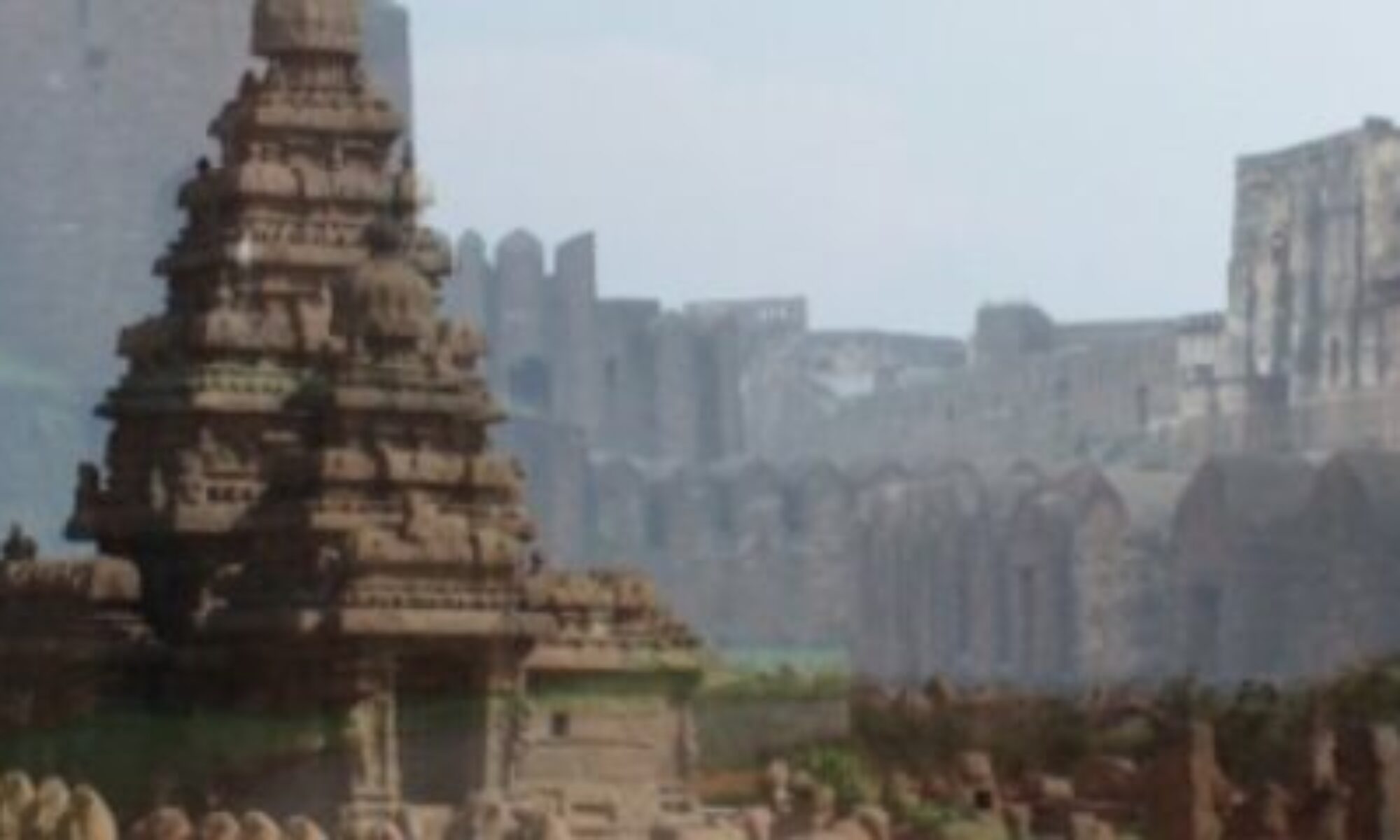It is advised to read about Jainism and its Iconography before you proceed.
The Jain caves at Ellora form almost a group by themselves separated from the Dhumar Lena by about 400 yard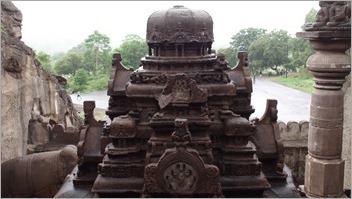 s. The group is a small one, consisting of five caves, two of them unfinished, but the two principal ones are extensive works. They are superior both in extent and elaboration to any of the Brahmanical caves, excepting of course the Kail
s. The group is a small one, consisting of five caves, two of them unfinished, but the two principal ones are extensive works. They are superior both in extent and elaboration to any of the Brahmanical caves, excepting of course the Kail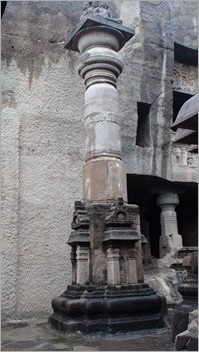 asa, and the Visvakarma among the Buddhist ones. Though two storeys in height and extremely rich in decoration, the Indra and the Jagannatha Sabha are entirely deficient in that purpose-like architectural expression which characterized the works of the two earlier religions. They have no cells, like the viharas, and are nothing like the Chaithya halls of the Buddhists, nor they are like the Dhumar Lena. Rich and elaborate though they certainly are, the plan is compressed, and all their arrangements seem to result from more accident than to have arisen from any well-conceived design, so that they lose half the effect that might have been produced with far less elaboration of detail.
asa, and the Visvakarma among the Buddhist ones. Though two storeys in height and extremely rich in decoration, the Indra and the Jagannatha Sabha are entirely deficient in that purpose-like architectural expression which characterized the works of the two earlier religions. They have no cells, like the viharas, and are nothing like the Chaithya halls of the Buddhists, nor they are like the Dhumar Lena. Rich and elaborate though they certainly are, the plan is compressed, and all their arrangements seem to result from more accident than to have arisen from any well-conceived design, so that they lose half the effect that might have been produced with far less elaboration of detail.
Cave 31 is a unfinished cave and we will proceed towards the Indra Sabha.
The Indra Sabha is actually a group of caves than a single one. It has two double storeyed caves and a single one, with subordinate chapels. Its court is ent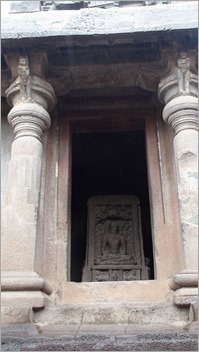 ered through a wall facing south. Outside this wall is a chapel with two pillars in front and two more at the back. The walls are sculpted with Parsvanatha, with a seven-hooded snake overshadowing him. On the other end is Gommata (Gomateswara) with a creeper twining around his limbs, with female attendants and worshippers.
ered through a wall facing south. Outside this wall is a chapel with two pillars in front and two more at the back. The walls are sculpted with Parsvanatha, with a seven-hooded snake overshadowing him. On the other end is Gommata (Gomateswara) with a creeper twining around his limbs, with female attendants and worshippers.
The screen wall is pierced by a doorway with a Dravidian roof. The court is about 56 feet inside from north to south and 48 feet across. In it stands an elephant on the right side, about 15 feet height (inclusive of the pedestal); a fine monolithic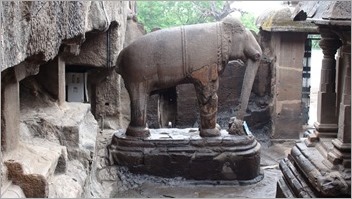 column 27 feet in height which was in a fallen state when excavated; and a small mantapa similar to the Nandi Mantapa like we see in Saiva temples. This mantapa is about 8 feet square inside, raised by 8 steps above the level of the court, with a door on each side.
column 27 feet in height which was in a fallen state when excavated; and a small mantapa similar to the Nandi Mantapa like we see in Saiva temples. This mantapa is about 8 feet square inside, raised by 8 steps above the level of the court, with a door on each side.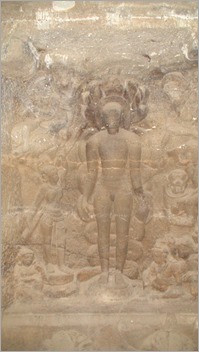 The roof is Dravidian in style Inside this room is a square block of rock, on each side if which is carved a figure of Mahavira, one of the Tirthankaras, with the wheel in front of the seat supported by lions.
The roof is Dravidian in style Inside this room is a square block of rock, on each side if which is carved a figure of Mahavira, one of the Tirthankaras, with the wheel in front of the seat supported by lions. 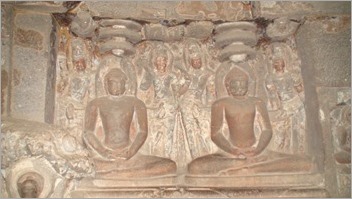
On the west side of the court is a hall with two pillars in front and four inside. In the central compartment is the sculpture of Parsvanatha, the 23rd Tirthankara and opposite to him is Gomateswara. These images are larger then the ones we had seen outside the wall. Exclusive of the verandah, the lower hall must have been intended to be around 72 feet wide by 56 feet deep, beyond which are two free standing pillars in front of the vestibule. However, it was left incomplete due to the quality of the rock. The shrine alone is comple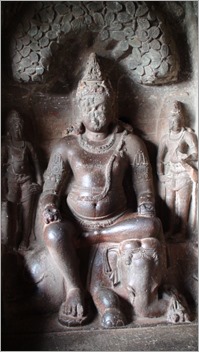 ted and containing a Mahavira seated cross-legged on a lion throne with the chakra (one of the emblems of the Digambara Jains) in front. In the center of the basement is a small shrine with the image of Mahavira carved on four sides of a pillar which is termed as a chaumukh pratima (Image on four sides)
ted and containing a Mahavira seated cross-legged on a lion throne with the chakra (one of the emblems of the Digambara Jains) in front. In the center of the basement is a small shrine with the image of Mahavira carved on four sides of a pillar which is termed as a chaumukh pratima (Image on four sides)
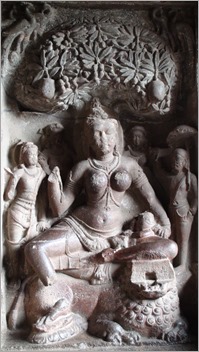 A stair ascends in the verandah and lands in the east end of the great hall above. The upper hall measures 55 feet deep and 78 feet wide. The verandah is separated by a low parapet wall is 54 feet long and 10 feet wide. At each end of it are colossal images of Matanga Yaksha (god of prosperity) and Siddhaika Yakshini (goddess of fertility) the former being seated on an elephant and the latter on a lion, with a tree behind the head of each and small figures of attendants behind them. The Banyan tree is behind the Yaksha and Mango behind the Yakshini. The carving is so detailed that we see monkeys and parrots carved and eating the mangoes. These figures are perhaps the Yaksha and Yakshini, the instructors of the Tirthankara
A stair ascends in the verandah and lands in the east end of the great hall above. The upper hall measures 55 feet deep and 78 feet wide. The verandah is separated by a low parapet wall is 54 feet long and 10 feet wide. At each end of it are colossal images of Matanga Yaksha (god of prosperity) and Siddhaika Yakshini (goddess of fertility) the former being seated on an elephant and the latter on a lion, with a tree behind the head of each and small figures of attendants behind them. The Banyan tree is behind the Yaksha and Mango behind the Yakshini. The carving is so detailed that we see monkeys and parrots carved and eating the mangoes. These figures are perhaps the Yaksha and Yakshini, the instructors of the Tirthankara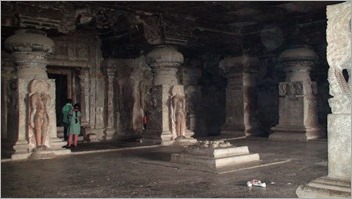 to whom the temple is dedicated.There are 48 of these Yakshas ad Yakshinis and one cannot be easily distinguished from the other.
to whom the temple is dedicated.There are 48 of these Yakshas ad Yakshinis and one cannot be easily distinguished from the other.
Behind each of the figures, but entered from the side aisles of the hall, is a small room of 9 feet by 11, by which access is obtained to the shrines on each side of the front area. A few steps lead down to a room carved all round with Jain figures. The main hall is about 25 feet wide and 24 feet deep, the roof supported by four square pillars with round capitals. On each side is a deep recess the right of which 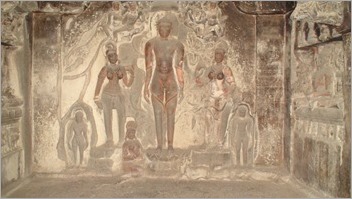 contains the statue of Gomateswara (also known as Bahubali). He is the son of the first Tirthankara, Adinatha. He is always represented with creeping plants twining themselves round his limbs, snakes coming out of ant-hills at his feet, his hair falling over his shoulders and attended by worshippers. The most prominent shrine of Gomateswara is at Shravanabelagola. The left part of the recess has the idol of Parsvanatha.
contains the statue of Gomateswara (also known as Bahubali). He is the son of the first Tirthankara, Adinatha. He is always represented with creeping plants twining themselves round his limbs, snakes coming out of ant-hills at his feet, his hair falling over his shoulders and attended by worshippers. The most prominent shrine of Gomateswara is at Shravanabelagola. The left part of the recess has the idol of Parsvanatha.
An interesting anecdote is that the Matanga Yaksha is also called “Indra” and so the cave named after him. There other numerous shrines in the same complex, however they are of the same type as the Indra sabha We will proceed towards the next cave, i.e. the Jagannatha Sabha. .
